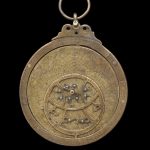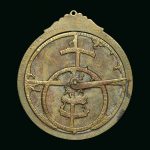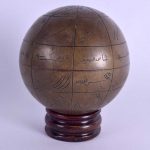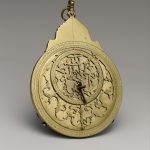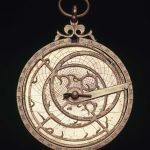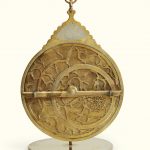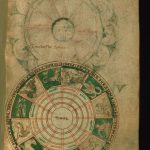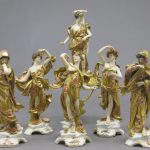An astrolabe is an instrument formerly used to make astronomical measurements, especially of the altitude of celestial bodies, and as an aid to navigation. In its earliest form (which dates from earliest time) it consisted of a disc with the degrees of the circle marked round its edge, and a pivoted pointer along which a celestial body could be sighted. From late medieval times it was used by mariners for calculating latitude, until replaced by the sextant. Reference: Museum of Applied Art and Sciences.
A rare Andalusian brass astrolabe Islamic Spain, 13th Century, probably before 1238 of cast brass, hammered and engraved with three lobed throne with shackle and suspension loop, rete, five plates, engraved in western kufic, to edge of back in later cursive script, later horse and pin, possibly later alidade 12.7 cm. max. FOOTNOTES Astrolabes were widely used in the Islamic world both for navigation and for finding the Qibla, or the direction of Mecca. They were also used to find the times of sunrise in order to help schedule morning prayers. During the Islamic period, numerous innovations were developed such as the addition of angular scales, adding circles indicating azimuths on the horizon. The present lot is a very rare example of an astrolabe which produced in Islamic Spain. Construction The limb was separately cast from the back plate, probably in one piece with a throne, possibly separately. In the former case the throne was broken off and the present throne, which may be the original but is not certainly so, attached or re-attached by two rivets. This operation caused the limb to fracture and the section between 42° and 75° was dovetailed back in. At the same time the upper part of the back plate was crudely re-riveted to the limb, three of the rivets being proud of the surface and breaking the engraving. The limb carries a 360° scale numbered by groups of 5 (with 100s but without 200s and 300s) and subdivided to single degrees. There is considerable wear to the numerals in the section running from 55° to 180°. In the first quadrant only (0°-90°) the 5° division lines are continued from the face of the limb over the edge to join the 5° lines on the back, the top of the back plate in this quadrant being notched for single degrees. Although the other quadrants are plain, the 180° and 270° positions are marked by a similar notch running over the limb to join the graduations on the face and back plate.
Sold for £ 82,500 inc. premium at Bonhams in 2017
Astrolabe (alidade missing). Made of brass. Culture/periodIslamic Date13th Century (after Gunther, 1932, p.279)
Reference: © The Trustees of the British Museum
AN ASTROLABE PROBABLY SPANISH OR FRENCH, LATE 15TH CENTURY The whole worn and rubbed rendering the engraving illegible in places, the mater with plain throne and loose suspension shackle, the rim engraved with 0-90° to each quadrant, the inside of the womb with circular opening cut through previous stereographic projection, four plates engraved to both sides with stereographic projections, one for 48° the final plate with shadow square to view through opening, the reverse of mater with calendrical scales and alidade, the rule attached to rete, horse replaced, the rete for 21 named stars. 4½in. (113mm.)
Sold for GBP 35,000 at Christies in 2018
A MIDDLE EASTERN BRONZE ASTROLABE GLOBE decorated with motifs. 11.5 cm wide.
Sold for £360 at Hannam’s Auctioneers Ltd in 2019
Planispheric Astrolabe Maker:Muhammad Zaman al-Munajjim al-Asturlabi (active 1643–89) Astrolabe dated A.H. 1065/ A.D. 1654–55
Astrolabes of this size were not precise enough for astronomical observations, but served well for telling time, and astrologers could use them to determine the position of a planet relative to the different astrological houses. The intricate calligraphic faceplate of this example is typical of Safavid‑period astrolabes; it reads: “In the name of God, the Merciful, the Compassionate” (bismallah al‑Rahman al‑Rahim).
Reference: The Metropolitan Museum of Art
Brass astrolabe from Persia, 1710 Made 1710 An astrolabe is an instrument formerly used to make astronomical measurements, especially of the altitude of celestial bodies, and as an aid to navigation. In its earliest form (which dates from earliest time) it consisted of a disc with the degrees of the circle marked round its edge, and a pivoted pointer along which a celestial body could be sighted. From late medieval times it was used by mariners for calculating latitude, until replaced by the sextant.
Reference: Museum of Applied Art and Sciences
Planispheric astrolabe Spanish (Barcelona) Medieval (Gothic) dated 1375 Petrus Raimundus
Foliated scroll attachment at top; the inner discs are engraved on both sides with circles and figures, the open-work piece above these is covered with engraved letters and figures.
The astrolabe is a two-dimensional model of the universe, used to tell time by measuring the altitudes of the sun or a selected fixed star at a given moment. Originating with the Greeks (its name comes from the ancient Greek astrolobos, “star-taker”) and refined by Muslim astronomers in the Middle Ages, it was one of the most important and versatile early scientific instruments. Beyond time-telling, its uses ranged from navigation to charting horoscopes, and it served as inspiration for later astronomical clocks like the one in this case. Signed and dated, this astrolabe is one of the earliest known European examples.
Around the edge is the inscription: ” + Hoc astralabium: fuit factum : et cum armillis verifficatum Barghionone : anno Xri 1375. per Petrum Raimodi de domo regis Aragonum : lati Barghinone : 41 longi 39″
Reference: Museum of Fine Arts Boston
A brass astrolabe copying the one by Muhammad Safi’ al-Munajjim signed and dated by Muhammad Muqim al-Yazdi, 1057 AH/1647-8 AD, Iran, 20th century on a modern stand D. 30 cm ; 11 3/4 in.
Sold for 4,750 EUR at Sotheby’s in 2018
This astrolabe is signed by one ‘Abd al-Aimmah’ and dated to the year 1715. Iranian astrolabes fall into two categories: those made from the 10th to the 16th centuries, which continue in much the same style as the earliest Iranian astrolabes; and those made from the end of the second half of the 16th century, when there was a resurgance in astrolabe-making. These later astrolabes are decorated in the highly ornate style popular in Iran at this period. Numerous surviving examples from the 17th and 18th centuries reflect the popularity of astrology at court. The retes of these astrolabes – that is, the part of the instrument that maps the stars, made up of a rotating disk with pointers – feature patterns of vine scrolls, bearing leaf-shaped star pointers. The various components, as well as the rims and the backs, usually have patterns or inscriptions, sometimes Persian verses in either naskh or nastaliq scripts. Astrolabes from this period also often have a signature within a cartouche below the shadow square on the back.
Reference: © Victoria and Albert Museum
